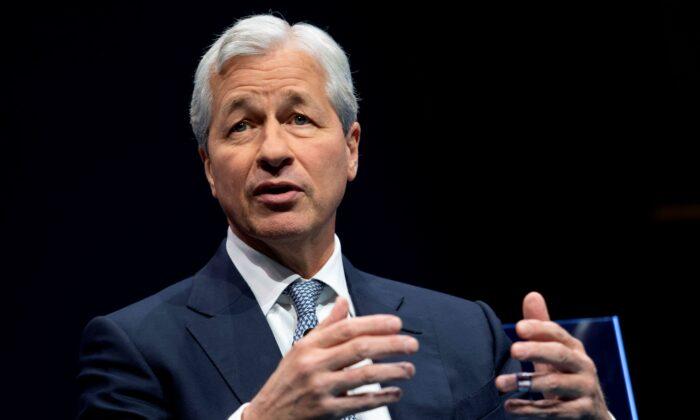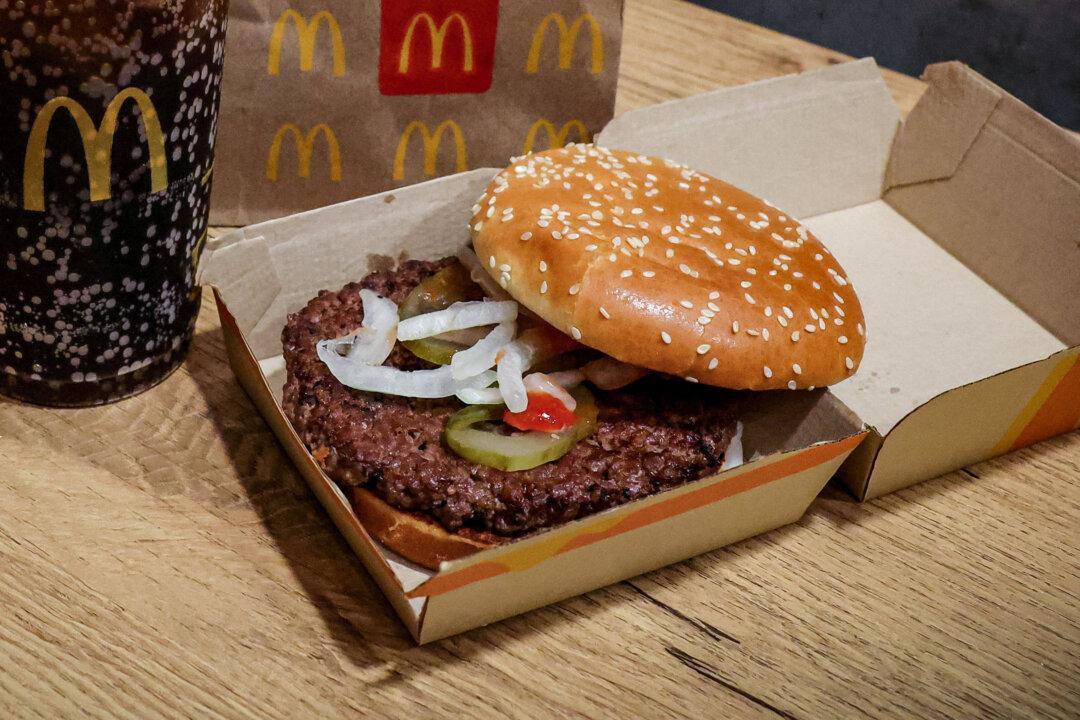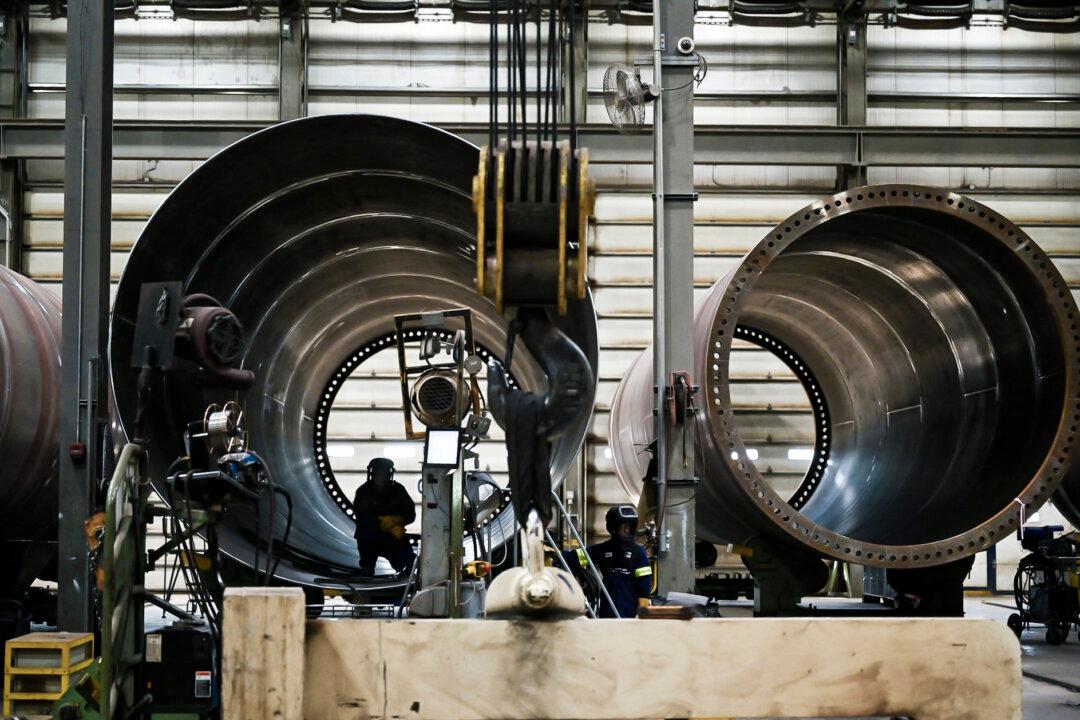JPMorgan Chase and Co. CEO Jamie Dimon said during an earnings call that he believes more banks could fail in the United States, but that he thinks the worst of the banking turmoil may be over and that things have calmed down “quite a bit.”
Uninsured deposits are those above the Federal Deposit Insurance Corp.’s (FDIC) coverage limit of $250,000 per depositor.
“There may be additional ... bank failures,” Dimon said, though he added that he thinks the worst may be over for the banking sector turmoil that was sparked by the recent collapse of Silicon Valley Bank (SVB), which led to an outflow of deposits from regional banks in particular.
“You’ve already seen things calm down quite a bit, particularly in deposit flows,” he said, adding that he expects regional banks to post strong numbers when they report earnings in the coming days.
On March 8, there was $16.25 trillion in deposits in U.S. banks, Fed data show. By March 29, that figure had dropped steadily to $15.95 trillion, down around $297 billion from before the SVB failure.
But by April 5, according to the latest available data, that trend had reversed and the number of total deposits had grown by around $44 billion, to nearly $16 trillion.
On the earnings call, Dimon also commented on Warren Buffett’s recent $1 million bet that depositors won’t lose any money even if their bank collapses, with the JPMorgan chief saying that Buffett’s wager should be seen as a reassuring sign that federal deposit insurance will work as it’s meant to.
When FDIC-insured banks fail, depositors with less than $250,000 in their accounts are fully reimbursed. Amounts above the coverage cap—which are uninsured—are at risk of being lost though in practice depositors typically get a portion of their uninsured deposits back in the recoveries process as the FDIC manages the sale of the failed bank’s assets.
“Warren Buffett was on TV talking about that he would bet $1 million ... that no depositor will lose money in America,” Dimon said of the wager announced recently by Buffett, whom he called a “very bright man.”
So while the crisis isn’t over yet, Dimon said, it eventually “will pass.”
Buffett, like Dimon, predicted in a recent interview on CNBC’s “Squawk Box” that “we’re not through with bank failures” yet.
At the same time, Buffett says he’s confident that deposit guarantees by the FDIC will, as they have in the past, protect insured depositors from losing their money in case of future bank failures.
“Banks can go bust, but depositors aren’t going to be hurt,” Buffett said, adding that he’s so confident that no insured deposits will be lost in U.S. banks that he’s willing to bet a $1 million on that outcome.
“You’re saying that you’ll put up $1 million against anybody who’s willing to take the other side of the bet that no depositor in a U.S. bank will lose money in the next year?” the interviewer asked Buffett.
Effects of Banking Turmoil to Linger
Earlier, Dimon said in a letter to shareholders that the U.S. banking crisis isn’t over, and that even when it does end, its impact will linger for years.The collapse of SVB triggered a crisis of confidence in the U.S. banking sector, prompting financial authorities to rush through a rescue package to stem a potential run on bank deposits that threatened broader financial instability.
When the crisis does eventually pass, it will lead to changes in the regulatory framework, Dimon argued, while cautioning against “knee-jerk, whack-a-mole, or politically motivated responses that often result in achieving the opposite of what people intended.”
Rather than rushing to over-regulate, Dimon urged U.S. financial authorities to “deeply think through and coordinate complex regulations” in order to achieve stated goals while getting rid of “costly inefficiencies and contradictory policies.”
“America has had, and continues to have, the best and most dynamic financial system in the world—from various types of investors to its banks, rule of law, investor protections, transparency, exchanges, and other features,” he wrote.
Recession Odds Rise
Dimon also said in the letter to shareholders that the banking sector turmoil from the collapse of SVB—along with the failure of Swiss lending giant Credit Suisse—has made a recession more likely.“The failures of SVB and Credit Suisse have significantly changed the market’s expectations, bond prices have recovered dramatically, the stock market is down, and the market’s odds of a recession have increased,” he wrote. “And while this is nothing like 2008, it is not clear when this current crisis will end.”
Dimon also predicted that credit supply would face a squeeze, though he added that it’s unclear whether the disruption would slow consumer spending.
“It remains to be seen whether this will cause a little bit of a cliff effect or whether consumer spending will simply slow down. Either way, this will add to whatever recessionary pressures there are sometime in the future,” he predicted.
In the here and now, Dimon said he sees signs of strength in the U.S. economy, including solid consumer spending, recovering supply chains, a healthy jobs market, and higher wages.
Looking ahead, however, he sees trouble brewing.
Storm Clouds Ahead
Besides the expected depletion of consumer excess savings, Dimon pointed to other factors clouding the economic outlook.This includes possibly persistent inflation, huge geopolitical strains, the unpredictable trajectory of the Russia–Ukraine war, and large quantitative tightening and “other unknowns” that reduce liquidity and trigger higher long-term interest rates.
Dimon blamed “unprecedented” fiscal spending over the past few years for pushing inflation to multi-decade highs and forcing the Federal Reserve into a rapid interest rate-hiking cycle to try to quash it.
“Fiscal stimulus is still surging through the system,” he said, insisting that it’s been inflationary and that multiplier effects of the stimulus mean that it still putting upward pressure on prices.
More deficit spending down the road—estimated at $1.4 trillion to $1.8 trillion per year over the next three years—is another factor that makes inflation harder to root out.
Nearly 12 years of quantitative easing, whereby the Fed expanded its balance sheet by buying government securities, drove interest rates down to near zero and flooded the economy with cheap money, consequently boosting stocks, real estate, and other assets.
As the Fed grapples with high inflation, it has reversed more than a decade of quantitative easing and has been reducing its balance sheet in what’s known as quantitative tightening, a process “whose full effect may not be known immediately,” Dimon said.
So far, the Fed has reduced its holdings of securities by around $550 billion and has committed to slashing those holdings by nearly $100 billion per month.
The current process of quantitative tightening puts upward pressure on interest rates and makes debt-servicing costs higher.
“While the central banks of the world are now selling instead of buying securities, the governments of the world have larger debts to finance. The United States alone needs to sell $2 trillion in securities, which must be absorbed in the market,” Dimon wrote.
He believes we are shifting from a savings glut to a scarcity of capital, along with higher interest rates and higher inflation than in the recent past.
“Essentially, we may be moving, as I read somewhere, from a virtuous cycle to a vicious cycle.”





